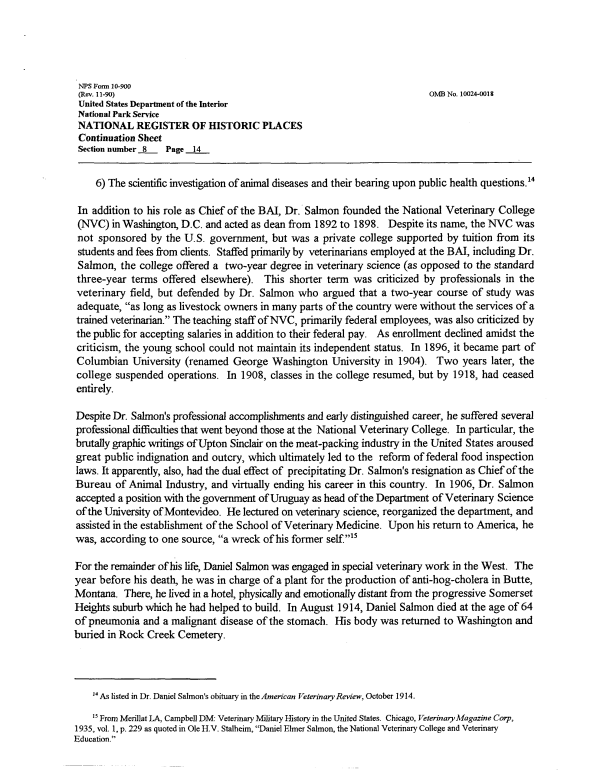 |
||||
|
DEPARTMENT OF HOUSING AND COMMUNITY DEVELOPMENT, MARYLAND HISTORICAL TRUST (Historic Sites Survey) var.d. MSA SE16-5 Image No: se16-5-0240 Enlarge and print image (76K) |
 |
||||
|
DEPARTMENT OF HOUSING AND COMMUNITY DEVELOPMENT, MARYLAND HISTORICAL TRUST (Historic Sites Survey) var.d. MSA SE16-5 Image No: se16-5-0240 Enlarge and print image (76K) |
| NPS Form 10-900 (Rev. 11-90) OMB No. 10024-0018 United States Department of the Interior National Park Service NATIONAL REGISTER OF HISTORIC PLACES Continuation Sheet Section number 8 Page 14 6) The scientific investigation of animal diseases and their bearing upon public health questions.14 In addition to his role as Chief of the BAI, Dr. Salmon founded the National Veterinary College (NVC) in Washington, D.C. and acted as dean from 1892 to 1898. Despite its name, the NVC was not sponsored by the U.S. government, but was a private college supported by tuition from its students and fees from clients. Staffed primarily by veterinarians employed at the BAI, including Dr. Salmon, the college offered a two-year degree in veterinary science (as opposed to the standard three-year terms offered elsewhere). This shorter term was criticized by professionals in the veterinary field, but defended by Dr. Salmon who argued that a two-year course of study was adequate, "as long as livestock owners in many parts of the country were without the services of a trained veterinarian." The teaching staff of NVC, primarily federal employees, was also criticized by the public for accepting salaries in addition to their federal pay. As enrollment declined amidst the criticism, the young school could not maintain its independent status. In 1896, it became part of Columbian University (renamed George Washington University in 1904). Two years later, the college suspended operations. In 1908, classes in the college resumed, but by 1918, had ceased entirely. Despite Dr. Salmon's professional accomplishments and early distinguished career, he suffered several professional difficulties that went beyond those at the National Veterinary College. In particular, the brutally graphic writings of Upton Sinclair on the meat-packing industry in the United States aroused great public indignation and outcry, which ultimately led to the reform of federal food inspection laws. It apparently, also, had the dual effect of precipitating Dr. Salmon's resignation as Chief of the Bureau of Animal Industry, and virtually ending his career in this country. In 1906, Dr. Salmon accepted a position with the government of Uruguay as head of the Department of Veterinary Science of the University of Montevideo. He lectured on veterinary science, reorganized the department, and assisted in the establishment of the School of Veterinary Medicine. Upon his return to America, he was, according to one source, "a wreck of his former self."15 For the remainder of his life, Daniel Salmon was engaged in special veterinary work in the West. The year before his death, he was in charge of a plant for the production of anti-hog-cholera in Butte, Montana. There, he lived in a hotel, physically and emotionally distant from the progressive Somerset Heights suburb which he had helped to build. In August 1914, Daniel Salmon died at the age of 64 of pneumonia and a malignant disease of the stomach. His body was returned to Washington and buried in Rock Creek Cemetery. 14 As listed in Dr. Daniel Salmon's obituary in the American Veterinary Review, October 1914. 15 From Merillat LA, Campbell DM: Veterinary Military History in the United States. Chicago, Veterinary Magazine Corp, 1935, vol. 1, p. 229 as quoted in Ole H.V. Stalheim, "Daniel Elmer Salmon, the National Veterinary College and Veterinary Education." |